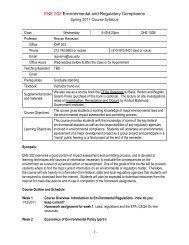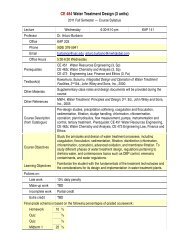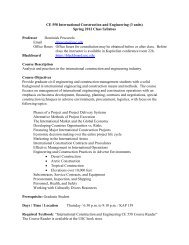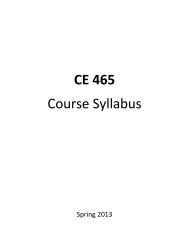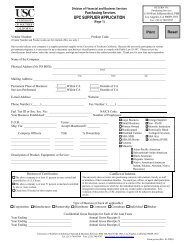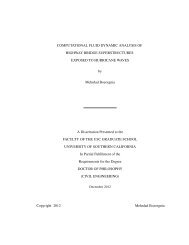CE 570 Building Information Modeling for Collaborative ... - USC
CE 570 Building Information Modeling for Collaborative ... - USC
CE 570 Building Information Modeling for Collaborative ... - USC
You also want an ePaper? Increase the reach of your titles
YUMPU automatically turns print PDFs into web optimized ePapers that Google loves.
<strong>CE</strong> <strong>570</strong> <strong>Building</strong> <strong>In<strong>for</strong>mation</strong> <strong>Modeling</strong> <strong>for</strong> <strong>Collaborative</strong> Construction Management (3 units)<br />
2011 Spring Semester — Class Syllabus page 1<br />
Professor<br />
Burcin Becerik-Gerber, Assistant Professor<br />
This syllabus will be<br />
Office<br />
Kaprielian Hall, 224C<br />
updated be<strong>for</strong>e fall<br />
Phone (213) 744-1426<br />
2011 class begins.<br />
Email<br />
beceric@usc.edu<br />
Other hours by appointment only. Students are advised to make appointments with the professor<br />
Office Hours ahead of time and be specific with the subject matter to be discussed. Students should also be<br />
prepared <strong>for</strong> their appointment by bringing all applicable materials and in<strong>for</strong>mation.<br />
Teaching Assistant Farrokh Jazizadeh<br />
Email<br />
jazizade@usc.edu<br />
Office Hours TA will lead workshop sessions and will hold regular office hours as posted<br />
Prerequisites <strong>CE</strong> 470. Recommended preparation: <strong>CE</strong> 556, <strong>CE</strong> 566<br />
Class Day(s),<br />
Location and Time<br />
TBD<br />
Required<br />
Textbook(s)<br />
Software<br />
and Reading<br />
Required Course<br />
TBD<br />
Please refer to Page 5 of this syllabus <strong>for</strong> a list of software and reading:<br />
• Related software: BIM Authoring and BIM Specialty<br />
• Recommended software<br />
• Recommended reading<br />
• Books<br />
Master of Construction Management<br />
• Track 4: Architecture, Engineering and Construction Technology Track<br />
COURSE DESCRIPTION — OPEN ONLY TO MASTER AND DOCTORAL STUDENTS<br />
Multidisciplinary and geographically distributed virtual project teams used to simulate engineering and construction problems<br />
<strong>for</strong> projects selected in collaboration with industry partners.<br />
This course was developed in response to the building industry’s need to overcome enormous technological and institutional<br />
changes and challenges, such as globalization, socio-economic changes, sustainability, specialization, and virtual collaboration.<br />
The 21 st century engineers and construction managers must be able to deal with a rapid pace of technological change, a highly<br />
interconnected world, and complex problems that require multidisciplinary solutions. BIM is one of the most successful<br />
technologies to offer a plat<strong>for</strong>m <strong>for</strong> multi-disciplinary teams to collaborate.<br />
COURSE OBJECTIVES<br />
<strong>Building</strong> <strong>In<strong>for</strong>mation</strong> <strong>Modeling</strong> (BIM) is argued to be a catalyst <strong>for</strong> change poised to reduce industry's fragmentation,<br />
improve its efficiency, effectiveness and lower the high costs of inadequate interoperability. Students will work in<br />
multidisciplinary project teams to simulate engineering and construction processes <strong>for</strong> actual projects. In one semester,<br />
students will focus on collaboratively designing and engineering optimal solutions, by utilizing in<strong>for</strong>mation technology and their<br />
individual strengths – problem solving from engineering students, design from architecture students, and schedule, cost, quality<br />
control and overall management from construction management students. By providing a cyber-learning plat<strong>for</strong>m, where<br />
students from multiple disciplines can work together, students will be able to test ideas, principles, and practices in the way to<br />
become creative and innovative practitioners. In addition, students will collaborate with their peers in Virginia Tech University<br />
(VTU), exploring bi-costal project collaboration and role-based learning. Distance Education Network (DEN) will enable students<br />
from two universities to follow software tutorials, lectures and participate in group discussions.<br />
Students should have familiarity with BIM software environments, or the willingness to learn them. All students enrolled in the<br />
course are expected to attend special skill-building lab sessions. This course is not intended to make students completely<br />
proficient in these environments. Instead, it aims to demonstrate how construction management functions are impacted by new<br />
technologies and helps students understand the fundamentals and practical uses of the state of the art in<strong>for</strong>mation technologies<br />
and tools in the building industry. It also promotes project-based learning through cross-disciplinary, geographically distributed,<br />
and virtual project team collaboration.<br />
Page1
<strong>CE</strong> <strong>570</strong> <strong>Building</strong> <strong>In<strong>for</strong>mation</strong> <strong>Modeling</strong> <strong>for</strong> <strong>Collaborative</strong> Construction Management (3 units)<br />
2011 Spring Semester — Class Syllabus page 2<br />
LEARNING OBJECTIVES<br />
Students will learn BIM authoring and specialty applications and construction management functions including<br />
construction simulation, model based estimating, energy analysis, clash detection and code compliance. In addition, they<br />
will gain the following skills and knowledge:<br />
• BIM skills and knowledge building<br />
• Application of BIM skills/knowledge to construction domain knowledge<br />
• Teamwork and team-building essentials<br />
• Understanding of the requirements needed <strong>for</strong> successful team collaboration<br />
• “Learning by doing”<br />
Methods<br />
of Teaching<br />
Class<br />
Communication<br />
Return of Course<br />
Assignments<br />
Grading Schema<br />
A combination of software tutorials, lectures, case studies, peer-to-peer learning and<br />
discussions. Additional out of class time required <strong>for</strong> directed self learning, seminar<br />
assignments, teamwork and reviewing relevant material.<br />
Scholar will be used <strong>for</strong> class communication, assignment submissions and reading materials.<br />
Adobe Connect will be used <strong>for</strong> sharing presentations and desktops. Each lecture will be<br />
recorded by DEN and streamlined via Scholar.<br />
Returned paperwork, unclaimed by a student, will be discarded after a year and hence, will not<br />
be available should a grade appeal be pursued following receipt of his/her grade.<br />
Software Assignments: 60% (10%<strong>for</strong> each assignment)<br />
Final Reports: 30% (10%<strong>for</strong> each report)<br />
Participation: 10%<br />
TEAM ASSIGNMENTS<br />
Roles and<br />
Responsibilities<br />
Role<br />
Six groups of four students will work on three projects (max 24 students). Each group will have<br />
two <strong>USC</strong> and two VTU students. Each student in every group will have the following roles:<br />
• Architect/Structural Engineer<br />
• <strong>Building</strong> Owner/Facility Manager<br />
• General Contractor<br />
• Project Manager<br />
Arch. Model<br />
Structural<br />
MEP Model<br />
Energy<br />
4-D<br />
Scheduling<br />
Estimating<br />
Clash<br />
Check<br />
Code<br />
Compliance<br />
Architect PRIMARY SECONDARY PRIMARY SECONDARY SECONDARY PRIMARY PRIMARY<br />
Engineer SECONDARY PRIMARY PRIMARY SECONDARY SECONDARY PRIMARY PRIMARY<br />
Cost Engineer SECONDARY SECONDARY SECONDARY SECONDARY PRIMARY SECONDARY SECONDARY<br />
Scheduler SECONDARY SECONDARY SECONDARY PRIMARY SECONDARY SECONDARY SECONDARY<br />
Construction<br />
Manager<br />
SECONDARY SECONDARY PRIMARY SECONDARY SECONDARY PRIMARY PRIMARY<br />
Page2
<strong>CE</strong> <strong>570</strong> <strong>Building</strong> <strong>In<strong>for</strong>mation</strong> <strong>Modeling</strong> <strong>for</strong> <strong>Collaborative</strong> Construction Management (3 units)<br />
2011 Spring Semester — Class Syllabus page 3<br />
TEAM ASSIGNMENTS<br />
All assignments and reports are to be completed by team. Instead of a midterm assignment, there will be six<br />
assignments and three final reports due at the beginning of the class as specified in the class schedule on page 6<br />
below.<br />
Guidelines and additional in<strong>for</strong>mation will be developed, which will provide a common vernacular <strong>for</strong> the assignments.<br />
It is crucial that students turn in whatever they have on the due date.<br />
• NO assignment will be accepted late.<br />
• An incomplete grade will only be issued when a student is unable to complete the work because of documented<br />
illness. A letter from your physician will be required documentation.<br />
Assignment No. 1<br />
DUE: 01/27/11<br />
Assignment No. 2<br />
DUE: 02/24/11<br />
• Compile scope: PDF drawings and design data/program<br />
• Compile schedule: MS project schedule or equivalent<br />
• Compile cost data: Gather cost and labor in<strong>for</strong>mation <strong>for</strong> the design and construction of a<br />
typical building<br />
• Establish group communication/collaboration procedures<br />
• Create a digital model, schedule and cost estimate <strong>for</strong> the building<br />
• Presentation: Teams present their models: comparable case and expected differences<br />
Assignment No. 3<br />
DUE: 03/17/11<br />
Assignment No. 4<br />
DUE: 03/31/11<br />
Assignment No. 5<br />
DUE: 04/21/11<br />
Assignment No. 6<br />
DUE: 04/28/11<br />
Final Report<br />
No. 1<br />
DUE: 05/05/11<br />
• Complete BIM based cost estimate and scheduling<br />
• Presentation: Teams present findings<br />
• Complete energy analysis<br />
• Presentation: Teams present their energy simulation findings<br />
• Complete clash checking and code compliance<br />
• Presentation: Teams present their findings<br />
• Refine final project model, estimate, schedule based on findings<br />
• Produce 3-D marketing documents/videos<br />
• Final presentations<br />
Each group will establish their communication/collaboration procedures and choose the tools to<br />
facilitate/support their procedures. Below is a list of suggested communication and collaboration<br />
tools. Each group may test different tools at the beginning of the semester but must choose at<br />
least one tool from each category and use them <strong>for</strong> group, vendor, and mentor<br />
communication/collaboration throughout the semester. Each group must deliver a report at the<br />
end of the semester. The report must include the following as a minimum requirement:<br />
• Basis/justification <strong>for</strong> choosing one tool over another<br />
• Pros/cons of each tool they have chosen<br />
• Frequency and method of use and reasoning <strong>for</strong> it (how much they used and what they have<br />
done and why)<br />
• Unique ways of use<br />
• Use by participants (who used what feature, who initiated the use, <strong>for</strong> what reason)<br />
• Detailed description of the communication and collaboration procedures established by the team<br />
• Explanation of how selected set of tools supported the team’s procedures<br />
Lessons Learned: what are the organizational, procedural and technological requirements <strong>for</strong><br />
collaborative project development; what has worked and what haven’t and why<br />
Page3
<strong>CE</strong> <strong>570</strong> <strong>Building</strong> <strong>In<strong>for</strong>mation</strong> <strong>Modeling</strong> <strong>for</strong> <strong>Collaborative</strong> Construction Management (3 units)<br />
2011 Spring Semester — Class Syllabus page 4<br />
TEAM ASSIGNMENTS<br />
Suggested Tools<br />
SYNCHRONOUS COLLABORATION:<br />
• http://tinychat.com/<br />
• http://www.tokbox.com/<br />
• http://www.dimdim.com/<br />
• Skype<br />
• MSN messenger<br />
• AOL Instant messenger<br />
• Yahoo messenger<br />
• Google voice and video chat<br />
• http://www.icq.com/<br />
• Google Wave is not available yet, but<br />
might be soon.<br />
ASYNCHRONOUS COLLABORATION:<br />
• http://www.ning.com/<br />
• http://www.groupsite.com/<br />
• http://secondlife.com/<br />
• http://www.facebook.com/<br />
• http://www.youtube.com/<br />
• http://twitter.com/<br />
Final Report<br />
No. 2<br />
DUE: 05/05/11<br />
Final Report<br />
No. 3<br />
DUE: 05/05/11<br />
At the end of the semester, each group will deliver a report <strong>for</strong> two categories: technology and<br />
process. This report will need to be supported by a thorough analysis of the project. The<br />
following areas (<strong>for</strong> both technology and process) should be covered in the report:<br />
• Interoperability<br />
• Enhancement list<br />
• Value proposition<br />
• Best practices <strong>for</strong> “how to work collaboratively” on the model<br />
Each student will work with assigned industry mentor, software vendor and his/her team<br />
members to define “what is needed” <strong>for</strong> and from his/her discipline area. Each group will submit<br />
a report at the end of the semester. Some of the questions that will be reported in a document<br />
as well as incorporated into the project are:<br />
• What level of in<strong>for</strong>mation is needed at each stage (design, construction and operations) and who<br />
is responsible <strong>for</strong> it<br />
• What is the level of detail<br />
• Who generates, produces, and organizes the ef<strong>for</strong>t<br />
• What are some of the liability issues and how to overcome them<br />
• Who owns the coordinated model<br />
• Who is responsible <strong>for</strong> quality control<br />
What are some of the standards needed to integrate all discipline's analytical and physical<br />
objects <strong>for</strong> simulation and per<strong>for</strong>mance<br />
Page4
<strong>CE</strong> <strong>570</strong> <strong>Building</strong> <strong>In<strong>for</strong>mation</strong> <strong>Modeling</strong> <strong>for</strong> <strong>Collaborative</strong> Construction Management (3 units)<br />
2011 Spring Semester — Class Syllabus page 5<br />
RELATED SOFTWARE ►<br />
BIM Authoring<br />
Graphisoft; ArchiCAD<br />
http://www.graphisoft.com/<br />
https://eduregistration.graphisoft.com/<br />
FREE <strong>for</strong> students<br />
Revit Architecture 2010/Structures/MEP http://students5.autodesk.com/ FREE <strong>for</strong> students<br />
BIM Specialty<br />
NavisWorks http://navisworks.com/ Model review and clash detection<br />
Solibri http://www.solibri.com/ Model review and clash detection<br />
Green <strong>Building</strong> Studio<br />
http://usa.autodesk.com/adsk/servlet/indexid=<br />
11179508&siteID=123112<br />
Energy and per<strong>for</strong>mance analysis<br />
Ecotect http://ecotect.com/home Energy and per<strong>for</strong>mance analysis<br />
Horizontal<br />
Meridian Proliance<br />
RECOMMENDED SOFTWARE ►<br />
Virtual Construction<br />
• 4-D scheduling, quantity take off and<br />
estimating, cost control and<br />
management<br />
Digital Project<br />
http://www.horizontal-llc.com/<br />
http://www.meridiansystems.com/<br />
http://www.vicosoftware.com/<br />
http://www.gehrytechnologies.com/<br />
Collaboration, estimating, 4-D<br />
simulation, clash check<br />
Construction project<br />
management<br />
FREE. Students can download<br />
software and training guides<br />
Innovaya http://www.innovaya.com/ Quantity take off and estimation<br />
Espec http://www.e-specs.com/demo-list.html Specifications<br />
SpecifiCAD http://www.cadalytic.com/ Product manufacturer content<br />
RECOMMENDED READING ►<br />
Websites and Blogs<br />
Analysis, Research and Reviews of AEC Technology - AECbytes<br />
<strong>Building</strong> Smart Alliance<br />
National BIM Standard (NIBS)<br />
FIATECH<br />
Eat your CAD<br />
BIM Forum<br />
All Things BIM<br />
All Roads Lead to BIM<br />
Books<br />
http://www.aecbytes.com/<br />
http://www.buildingsmartalliance.org/<br />
http://www.facilityin<strong>for</strong>mationcouncil.org/bim/index.php<br />
http://www.fiatech.org/<br />
http://www.eatyourcad.com/<br />
http://www.bim<strong>for</strong>um.org/<br />
http://allthingsbim.blogspot.com/<br />
http://www.digitalvis.com/allroads<br />
BIM Handbook: A Guide to <strong>Building</strong> <strong>In<strong>for</strong>mation</strong> <strong>Modeling</strong> <strong>for</strong> Owners, Managers, Designers, Engineers and Contractors-<br />
Chuck Eastman, et al.<br />
<strong>Building</strong> <strong>In<strong>for</strong>mation</strong> <strong>Modeling</strong>: A Strategic Implementation Guide <strong>for</strong> Architects, Engineers, Constructors, and Real Estate<br />
Asset Managers — Dana K. Smith and Michael Tardif<br />
<strong>Building</strong> <strong>In<strong>for</strong>mation</strong> <strong>Modeling</strong>: Planning and Managing Construction Projects with 4-D CAD and Simulations - Willem Kymmell<br />
BIM and Construction Management: Proven Tools, Methods, and Workflows — Brad Hardin<br />
Page5
<strong>CE</strong> <strong>570</strong> <strong>Building</strong> <strong>In<strong>for</strong>mation</strong> <strong>Modeling</strong> <strong>for</strong> <strong>Collaborative</strong> Construction Management (3 units)<br />
2011 Spring Semester — Class Syllabus page 6<br />
COURSE SCHEDULE<br />
HOMEWORK<br />
WEEK DATE TOPICS ASSIGNED DUE<br />
1 01/13<br />
2 01/20<br />
3 01/27<br />
4 02/03<br />
5 02/10<br />
6 02/17<br />
7 02/24<br />
8 03/03<br />
9 03/10<br />
10 03/17<br />
11 03/24<br />
12 03/31<br />
13 04/07<br />
14 04/14<br />
15 04/21<br />
INTRODUCTIONS<br />
• Instructors, class members and course assignments<br />
• Team <strong>for</strong>mation; roles and responsibilities<br />
• Integrated Practice and Collaboration<br />
• Fundamentals of BIM<br />
INTEGRATED PROJECT SESSION — Session 1<br />
• Integrated team <strong>for</strong>mation, definition of design intent, responsibilities, cost, schedule and<br />
systems benchmarking<br />
BIM application tutorial – Revit and ArchiCAD<br />
• Overview of BIM application: interface, navigation, intro to massing models and concept design<br />
• Parametric structures in BIM: using constrains and general modeling family, setting up stories,<br />
creating slabs, etc.<br />
• BIM walls and openings<br />
BIM application tutorial – Revit and ArchiCAD<br />
• Visualization and documentation: extracting in<strong>for</strong>mation from BIM and drawing production:<br />
measurement data, schedule of values, custom annotations<br />
• Interoperability: model linking, collaboration and team communication within BIM, translation of<br />
relevant data<br />
BIM application tutorial - Navisworks<br />
• Linking MS Project with BIM; 4D simulation in BIM<br />
• Quantity take offs with BIM, schedules, inventories<br />
• Clash detection<br />
INTEGRATED PROJECT SESSION — Session 2<br />
Virtual model development, analysis: modeling<br />
BIM based project management – Meridian Proliance<br />
• RFIs, submittals, estimating, budgets, notices, etc<br />
BIM based collaboration– Horizontal Glue<br />
• Introduction to Web-based BIM<br />
• Spatial coordination, quantities and volumes, simulation, mark-ups, notices, records in a Webbased<br />
environment<br />
INTEGRATED PROJECT SESSION — Session 3<br />
Virtual model development, analysis: schedule and estimating/cost<br />
BIM application tutorial – Ecotect and GBS<br />
• Sustainability and BIM: Interface with energy analysis packages <strong>for</strong> green design/construction,<br />
design optimization, energy analysis<br />
INTEGRATED PROJECT SESSION — Session 4<br />
Virtual model development, analysis: energy<br />
FACILITIES INTEGRATION<br />
• How to prepare in<strong>for</strong>mation to link <strong>for</strong> FM purposes<br />
• Extract and <strong>for</strong>mat in<strong>for</strong>mation involving standards like COBIE<br />
Model Checking and Validation - Solibri<br />
• Code compliance, egress analysis, space usage, quality assurance, program validation<br />
INTEGRATED PROJECT SESSION — Session 5<br />
• Virtual model development, analysis: clash check and code checking<br />
No. 1<br />
No. 2<br />
No. 3<br />
No. 4<br />
No. 5<br />
No. 1<br />
No. 2<br />
No. 3<br />
No. 4<br />
No. 6 No. 5<br />
16 04/28 Team Presentations No. 6<br />
05/05 Final project delivery<br />
Final<br />
Reports<br />
1, 2, 3<br />
Page6
<strong>CE</strong> <strong>570</strong> <strong>Building</strong> <strong>In<strong>for</strong>mation</strong> <strong>Modeling</strong> <strong>for</strong> <strong>Collaborative</strong> Construction Management (3 units)<br />
2011 Spring Semester — Class Syllabus page 7<br />
STATEMENT ON ACADEMIC INTEGRITY<br />
The University, as an instrument of learning, is predicated on the existence of an environment of integrity. As members of<br />
the academic community, faculty, students, and administrative officials share the responsibility <strong>for</strong> maintaining this<br />
environment.<br />
• Faculty have the primary responsibility <strong>for</strong> establishing and maintaining an atmosphere and attitude of academic<br />
integrity such that the enterprise may flourish in an open and honest way.<br />
• Students share this responsibility <strong>for</strong> maintaining standards of academic per<strong>for</strong>mance and classroom behavior<br />
conducive to the learning process.<br />
• Administrative officials are responsible <strong>for</strong> the establishment and maintenance of procedures to support and<br />
en<strong>for</strong>ce those academic standards.<br />
Thus, the entire University community bears the responsibility <strong>for</strong> maintaining an environment of integrity and <strong>for</strong> taking<br />
appropriate action to sanction individuals involved in any violation. When there is a clear indication that such individuals<br />
are unwilling or unable to support these standards, they should not be allowed to remain in the University.” (Faculty<br />
Handbook, 1994:20)<br />
Academic dishonesty includes: (Faculty Handbook, 1994: 21-22)<br />
• Examination behavior – any use of external assistance during an examination shall be considered academically<br />
dishonest unless expressly permitted by the teacher.<br />
• Fabrication – any intentional falsification or invention of data or citation in an academic exercise will be<br />
considered a violation of academic integrity.<br />
• Plagiarism – the appropriation and subsequent passing off of another’s ideas or words as one’s own. If the<br />
words or ideas of another are used, acknowledgment of the original source must be made through recognized<br />
referencing practices.<br />
Other Types of Academic Dishonesty – submitting a paper written by or obtained from another, using a paper or essay in<br />
more than one class without the teacher’s express permission, obtaining a copy of an examination in advance without the<br />
knowledge and consent of the teacher, changing academic records outside of normal procedures and/or petitions, using<br />
another person to complete homework assignments or take-home exams without the knowledge or consent of the teacher.<br />
The use of unauthorized material, communication with fellow students <strong>for</strong> course assignments, or during a mid-term<br />
examination, attempting to benefit from work of another student, past or present and similar behavior that defeats the<br />
intent of an assignment or mid-term examination, is unacceptable to the University. It is often difficult to distinguish<br />
between a culpable act and inadvertent behavior resulting from the nervous tensions accompanying examinations. Where<br />
a clear violation has occurred, however, the instructor may disqualify the student’s work as unacceptable and assign a<br />
failing mark on the paper.<br />
STATEMENT FOR STUDENTS WITH DISABILITIES<br />
Any student requesting academic accommodations based on a disability is required to register with Disability Services and<br />
Programs (DSP) each semester. A letter of verification <strong>for</strong> approved accommodations can be obtained from DSP. Please<br />
be sure the letter is delivered to me (or to TA) as early in the semester as possible.<br />
DSP Contact <strong>In<strong>for</strong>mation</strong><br />
• Office Location: STU 301<br />
• Open: 8:30 a.m. until 5:00 p.m., Monday through Friday.<br />
• Phone number: (213) 740-0776<br />
Page7




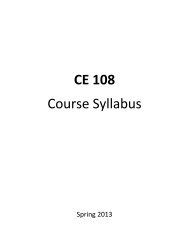
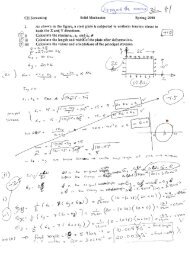
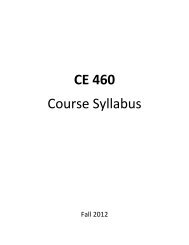
![Dr. Yan Xiao Bamboo Road Bridge can Support 16-Ton[ne] - USC](https://img.yumpu.com/37910641/1/190x245/dr-yan-xiao-bamboo-road-bridge-can-support-16-tonne-usc.jpg?quality=85)
